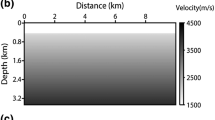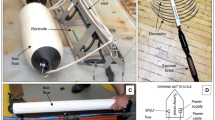Abstract
Predictive deconvolution is an effective way to suppress multiple reflections, especially short path multiples, in seismic data. However, the effectiveness of the predictive deconvolution decreases with increasing offset for the shot data. The design and application of the predictive deconvolution filter are based on two significant parameters, prediction lag and operator length, which are generally used as constant along the offset in the application of conventional predictive deconvolution (CPD). In addition to the effect of the wavelet characteristics of the input seismic data, the operator length is related to the performance of the predictive deconvolution filter while the prediction lag controls the temporal resolution of the input trace. If these parameters are determined by considering near offsets on the autocorrelation window, the primary reflections at far offsets will be attenuated. Conversely, if considering far offsets, then the performance of the predictive deconvolution filter reduces in the elimination of the multiples. In this study, to overcome this trade-off between the near and far offsets, these two parameters are used as variable with increasing offset and it is called offset-dependent predictive deconvolution (ODPD). Detailed analyses of this approach were performed on two synthetics including two specific types of short path multiples such as water bottom peg-leg, intrabed and real marine seismic data. It is observed that operator length should be selected long enough to improve the performance of the predictive deconvolution, especially at the nearest offsets. In addition, if the prediction lag is taken longer than second zero crossing of the autocorrelogram, then the reflection amplitudes from particularly deeper layers are better preserved. It is concluded that the use of the offset varying parameters increases the efficiency of the predictive deconvolution filter and preserves reflection amplitudes, leading to a better signal-to-noise ratio (S/N) of the seismic data.















Similar content being viewed by others
References
Costain JK, Çoruh C (2004) Basic theory of exploration seismology seismic exploration, vol 1. Elsevier, Amsterdam, pp 418–499
Dondurur D (2018) Acquisition and processing of marine seismic data. Elsevier Science Publishing Co, Amsterdam
Gibson B, Larner K (1984) Predictive deconvolution and zero phase source. Geophysics 49:379–397
Güney R, Karslı H, Dondurur D (2012) Offset-dependent predictive deconvolution. Jeofizik 17:3–12 (in Turkish)
Levinson N (1947) The Wiener RMS (root mean square) error criteria in filter design and prediction. J Math Phys 25:261–278
Liu J, Lu W (2008) An improved predictive deconvolution based on maximization of non-Gaussianity. Appl Geophys 5:189–196
Liu L, Lu W (2014) Non-Gaussianity based time varying predictive deconvolution for multiple removal. SEG Denver 2014 Annual Meeting, Expanded Abstracts Book, pp 4162–4166
Margrave GF, Lamoreux MP (2010) Non-stationary predictive deconvolution. GeoCanada 2010-working with Earth, pp 1–4
Peacock KL, Treitel S (1969) Predictive deconvolution: theory and practice. Geophysics 34:155–169
Perez MA, Hanley DC (2000) Multiple attenuation via predictive deconvolution in the radial domain. 12th Annual Research Report of CREWES Project
Porsani MJ, Ursin B (1998) Mixed-phase deconvolution. Geophysics 63:637–647
Porsani MJ, Ursin B (2007) Direct multichannel predictive deconvolution. Geophysics 72:11–27
Robinson EA (1957) Predictive decomposition of seismic trace. Geophysics 22:767–779
Robinson EA (1967) Predictive decomposition of time series with application to seismic exploration. Geophysics 32:418–484
Robinson EA (1975) Dynamic predictive deconvolution. Geophys Prospect 23:779–797
Robinson EA, Treitel S (1980) Geophysical signal analysis. Prentice Hall, New Jersey, pp 22–35
Schoenberger M, Houston LM (1998) Stationarity transformation of multiples to improve the performance of predictive deconvolution. Geophysics 63:723–737
Shankar U, Singh SS, Sain K (2009) Signal enhancement and multiple suppression using Radon transform: an application to marine multichannel seismic data. Mar Geophys Res 30:85–93
Taner MT (1980) Long-period sea floor multiples and their suppression. Geophys Prospect 28:30–48
Taner MT, Coburn KW (1981) Surface-consistent estimation of source and receiver response functions. Geophysics 46:412–413
Treitel S, Gutowski PR, Wagner DE (1982) Plane-wave decomposition of seismograms. Geophysics 47:1375–1401
Ulrych TJ, Matsouka T (1991) The output of Predictive Deconvolution. Geophysics 56:371–377
Ulrych TJ, Sacchi MD (2005) Information-based inversion and processing with applications. Elsevier, Amsterdam
Verschuur DJ (2006) Seismic multiple removal techniques: past, present and future. EAGE, Houten
Wang B, Cai J, Guo M, Mason C, Gajawada S, Epili D (2011) Post migration multiple prediction and removal in the depth domain. Geophysics 76:WB217–WB223
Weglein AB (1999) Multiple attenuation: an overview of recent advance and the road ahead. Lead Edge 18:40–44
Yılmaz Ö (2001) Seismic data analysis: processing, inversion and interpretation of seismic data. Society of Exploration Geophysicists, Tulsa
Acknowledgements
We wish to express our appreciation to the Chief Editor Dr. Claudio Lo Iacono, the reviewer Rafael Bartolome and an anonymous reviewer for the valuable suggestions and constructive reviews. We also would like to thank Dokuz Eylül University, Institute of Marine Science and Technology for providing the marine seismic data.
Author information
Authors and Affiliations
Corresponding author
Additional information
Publisher's Note
Springer Nature remains neutral with regard to jurisdictional claims in published maps and institutional affiliations.
Rights and permissions
About this article
Cite this article
Güney, R., Karslı, H. & Dondurur, D. Optimum parameter selection in offset-dependent predictive deconvolution: testing on multichannel marine seismic data. Mar Geophys Res 40, 601–617 (2019). https://doi.org/10.1007/s11001-019-09390-w
Received:
Accepted:
Published:
Issue Date:
DOI: https://doi.org/10.1007/s11001-019-09390-w




